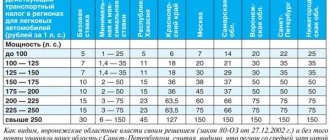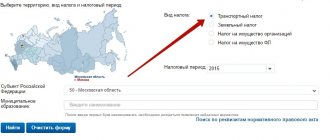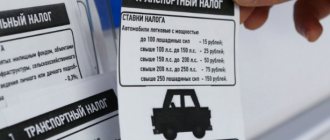Home / News and changes
Back
Published: March 26, 2019
Reading time: 43 min
0
428
Transport tax is one of three types of property tax established in the Russian Federation. In addition to transport, the population pays contributions to the budget for the use of real estate and land.
- Current legislature
- Calculator
- Calculation procedure
- Transport tax in 2021 Tax incentives
- Table by region
Current legislature
Transport tax is regional. This means that the constituent entities of the Russian Federation independently determine what rate to set for each tax period. Their actions are limited by federal law. Regions cannot set rates higher than the amount specified in the Tax Code of the Russian Federation (Chapter 28 of the Tax Code of the Russian Federation).
Federal legislation determines the tax base (what is taken as the basis for calculation), the object of taxation (for which vehicles the tax is paid and for which not), taxpayers (who must pay to the treasury), the tax period (when and for what period the tax is paid).
For 2021, taxpayers are considered to be the owners of vehicles on which tax must be paid.
The Tax Code defines transport that is not subject to tax:
- Rowing and motor boats of low power (up to 5 HP).
- Passenger cars equipped for disabled people.
- Sea and river vessels engaged in fishing.
- Passenger and cargo ships of any kind (airplanes, river transport) that are officially used for transportation.
- Agricultural transport used for agricultural work.
- Transport used by executive authorities and federal government agencies and used for military purposes.
- Vehicles that are officially recognized as stolen.
- Air ambulances.
- Drilling ships.
The tax is calculated based on the vehicle's power. For vehicles equipped with an engine, this is horsepower; for air transport - kilograms of force; for water - gross tonnage in registered tons.
The amount to be paid is determined for each unit of power.
The code specifies base rates; they can be increased by constituent entities of the Russian Federation, but not more than 10 times. The law allows for differentiated rates to be established, including the age of the car and the environmental class in the calculation (clause 3 of Article 316 of the Tax Code of the Russian Federation).
Tax calculations for individuals are carried out by tax authorities independently. A multiplying factor may be included in the formula. It is determined by the cost of the car and its age:
- 1.1 – for cars not older than 3 years , costing from 3 to 5 million rubles;
- 2 – for cars aged 5 years and younger with a cost of 5 to 10 million rubles;
- 3 – for cars not older than 10 years , costing from 10 to 15 million rubles or cars under 20 years worth more than 20 million rubles.
Last news
- Latest news: The Ministry of Finance opposed the abolition of the transport tax, justifying it by the fact that the inclusion of this burden in excise taxes on fuel - which is exactly how the tax was initially proposed to be changed - will greatly affect the rise in prices for gasoline and diesel fuel. And this, in turn, will significantly increase the cost of all goods, because their transportation will now become much more expensive.
- Another reason given by the Ministry of Finance is that for 2021, funds from the tax on passenger cars in Russia go directly to the budgets of the regions where it is collected. And they are already distributing them to road funds. Thus, if the transport tax is abolished, the quality of roads in the regions may deteriorate.
- Another recent information is that in May 2018, another bill was introduced to the State Duma, which proposes to abolish the transport tax on electric passenger cars in Russia. It is currently under consideration and has not yet entered into legal force.
- In February 2021, the Tax Policy Department sent a letter to the Ministry of Finance with a proposal to consider the issue of canceling or reducing the transport tax rate for large families. As of February 2, 2021, there have been no changes in this regard yet.
- From January 2021, changes in increasing coefficients for expensive cars are in effect (but this is not a luxury tax, but a transport tax). The changes affected passenger cars costing from 3 million rubles. New coefficients with fresh amendments are given in the table below.
Transport tax rates for expensive cars after changes in January 2021
| Car cost | Age | Tax coefficient |
| 3-5 million rubles | Less than 3 years | 1,1 |
| 5-10 million rubles | Less than 5 years | 2 |
| 10-15 million rubles | Less than 10 years | 3 |
| More than 15 million rubles | Less than 20 years | 3 |
Transport tax in 2021
In 2021, federal transport tax legislation has not undergone radical changes. The amount to be paid is calculated based on the type of vehicle, its cost, power, period of use and the category to which it belongs.
Tax benefits
Federal legislation does not provide special benefits for transport tax payers. At the same time, the Tax Code allows for the independent establishment of benefits by constituent entities of the Russian Federation (Article 356 of the Tax Code of the Russian Federation). What benefits a car owner can claim depends on his region of residence. Most often, WWII veterans, disabled people, and pensioners fall into the preferential category. Recently, the legislative bodies of many regions have taken initiatives to introduce significant benefits for cars running on natural gas. For example, the Samara Provincial Duma Committee on Transport proposed introducing such a benefit at the beginning of 2021.
You can see what benefits are provided in each individual region on the official website of the Tax Inspectorate in the “Reference Information” section.
The tax office itself calculates the tax and sends a notification to the car owner. The calculation will also include a benefit, but only if the Federal Tax Service is aware that the payer is entitled to it. The owner himself must track whether he has received a subsidy. This requires:
- Check whether the benefit is due in accordance with the tax laws of the region of residence.
- Calculate the tax amount using a calculator , including the benefit in the calculation.
- Compare the resulting amount with the one indicated in the tax notice.
- If the amounts do not match, you should contact the Federal Tax Service with a request for recalculation.
This can also be done online. At the same time, having a personal account on the tax office website is not required. On the Federal Tax Service portal you need to follow the links: Main page - Electronic services - Contact the Federal Tax Service of Russia - Appeal from an individual regarding a life situation.
The service was organized to speed up and facilitate the procedure for recalculating incorrectly assessed property taxes.
Who is exempt from paying tax?
There is a common misconception; many people believe that only car owners pay transport tax. However, according to the Tax Code, owners of other vehicles such as:
- motorcycles;
- boats;
- buses;
- ATVs;
- yachts;
- helicopters;
- tractors;
as well as owners of other vehicles are required to pay contributions to the state treasury.
According to the Tax Code, the following vehicles can be classified as preferential categories of transport:
- Cars received free of charge by citizens from various social institutions under government programs for those in need. This category includes passenger cars that have been converted to be driven by people with disabilities, have a disability group and are registered with the traffic police as disabled.
- Cars that have been stolen are exempt from payment. The period without payment is calculated from the date of filing the application with law enforcement agencies. It ends when internal affairs officers return the car to its owner.
- Swimming devices intended for industrial work, which are designed for movement in sea and river bodies of water.
- Vehicles that are used for agricultural purposes. Such purposes are considered to be: transportation of livestock, various feeds, manufactured products to stores and warehouses. This category also includes tractors and combines.
- Boats and boats, the engine of which has a power not exceeding five horsepower.
Rates
Tax rates are also set by each region independently, with restrictions imposed by the Tax Code.
For automobiles, the base rate is calculated based on horsepower , measured in horsepower. For each power you will have to pay a certain amount of rubles.
Differentiation of the rate means that it can change based on the age of the car and its environmental class . The specific differentiation coefficient is determined by the regional leadership.
The rates of individual constituent entities of the Russian Federation can be found on the Federal Tax Service website in the section “Reference information on rates and benefits for property taxes.”
The difference between rates for the same car in different regions can reach 100 percent or more. For example, for a car with a capacity of 100 to 150 HP in the Altai Republic they will pay 14 rubles per unit, and in Bashkortostan - 35.
When a region has not established its own rates, those specified in the Tax Code are applied (clause 4 of Article 361 of the Tax Code of the Russian Federation).
Key issues to face
Naturally, such an event could not but cause a huge resonance and literally in an instant it spread everywhere. Of course, there were those who did not blindly believe all this, but simply clarified the information by calling their lawyer or a lawyer they knew. But most often I heard questions of the following nature:
- I recently heard somewhere that Putin signed a law according to which the transport tax in the Russian Federation will be abolished - is this true? Since it’s being canceled for cars, maybe it’s just around the corner for trucks? I would like to take full advantage of this opportunity;
- Tell me, will the transport tax really be abolished from January 1, 2021? Will debts for previous years (in my case for 2021 and 2021) also be written off? Does it really take effect on January 1st and not later?
- I basically didn’t pay this type of tax for two years. It was also not enough to collect money from me from here. I hope it really was cancelled. Is it so?
And this is only a small part of the issues that lawyers have had to deal with. The smallest fraction of them. Our people quickly cling to the information they would like to hear, forward fake articles to each other, and much more. But is there at least something plausible in this?
The excitement arose due to the fact that almost a year ago a bill was introduced into the State Duma that would actually abolish this type of tax upon its entry into force. However, no entry into force has taken place and will definitely not happen in the coming years. Accordingly, all these discussions created around the abolition of the transport tax are nothing more than human dreams.
Why does the transport tax need to be abolished?
It was the injustice of the transport tax that led to demands for its abolition. Today the tax is calculated based on the power of the vehicle. Owners must pay it:
- passenger cars;
- motorcycles;
- scooters;
- tracked vehicles.
Transport tax is calculated by multiplying the tax rate by the tax base. The tax rate depends on:
- machine power;
- vehicle categories;
- Year of release;
- region in which the tax rate is established.
The tax base is the number of horsepower that determines the power of a vehicle engine. When calculating transport tax, an increasing coefficient can also be applied. It is used for all cars over 3,000,000 rubles.
The above calculation of transport tax causes a lot of outrage and indignation. He is not considered fair. Some people regularly use a car and make long trips. Some people use the vehicle only on weekends. For example, pensioners can travel by car exclusively in the summer to their summer cottages. However, the tax is calculated without taking into account the operating time of the vehicle, but depends on the power of the car. That is why the abolition of transport tax for individuals remains a pressing topic.
It is worth noting that in recent years, many regions have abolished the transport tax for large families. Thus, the authorities recognize that there are cases when owning a car is a necessity and should not be subject to the levy.
Tripods on the roads - is this legal in 2021?
Moscow city law on transport tax
The legislative bodies of Moscow and the Moscow region independently establish rates, benefits, terms and other rules for payment of TN. These rules are regulated by Law No. 33 of Moscow “On Transport Tax” and Law of the Moscow Region No. 129/2002-OZ, respectively.
Local legislation has the right to regulate the timing of tax payment only for legal entities. Payment term for TN for individuals. individuals is the same for all regions of the country - until December 1, 2021 for the last tax period (2020).
According to the Law of Moscow and the Law of the Moscow Region on transport tax for 2021, the following tax rates for passenger cars have been established for residents of the region:
| Engine power hp (kW) | Rate (RUB) for Moscow | Rate (rub.) for the Moscow region. |
| up to 100 hp (up to 73.55 kW) | 12 | 10 |
| 101 - 125 hp (73.55 - 91.94) | 25 | 34 |
| 126 - 150 hp (91.94 - 110.33) | 35 | 34 |
| 151 hp - 175 hp (110.33 - 128.7) | 45 | 49 |
| 176 - 200 hp (128.7 - 147.1) | 50 | 49 |
| 201 - 225 hp (147.1 - 165.5) | 65 | 75 |
| 226 - 250 hp (165.5 - 183.9) | 75 | 75 |
| from 251 hp (from 183.9) | 150 | 150 |







